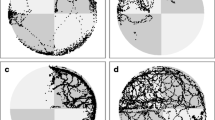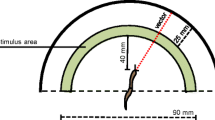Summary
The escape response decrement shown by the crabChasmagnathus granulatus as a consequence of repeated shadow presentation, meets five of the seven tested parametric criteria of habituation. Results concerning stimulus generalization and dishabituation strongly suggest that neither motor fatigue nor sensory adaptation can account for the response waning. The effects of morphine and naloxone on performance were also studied. Neither 50 nor 5 μg morphine/g exerted any modulatory effect on memory retention. A dose of 50 μg morphine/g produced an anterograde detrimental effect on responsiveness but no long-term training effects could be detected after the drug's period of action. A dose of naloxone of 1.6 μg/g did not antagonize the effect of morphine. The potential value of the response habituation as a model for studying both habituation dynamics and the mechanisms that subserve it, and also for elucidating the effects of opiates on this memory process, is discussed.
Similar content being viewed by others
Abbreviations
- ANOVA :
-
analysis of variance
- d.w. :
-
distilled water
- ITI :
-
intertriai interval
- LOR :
-
large opaque rectangle
- M P :
-
morphine-HCl
- NX :
-
naloxone
- S1 :
-
first trial session
- S2 :
-
second trial session
- S3 :
-
third trial session
- S4 :
-
fourth trial session
- S5 :
-
fifth trial session
- SOR :
-
small opaque rectangle
- STR :
-
small translucent rectangle
References
Boschi EE (1972) Los crustaceos decapodos brachyura del litoral bonaerense. Bol Inst Biol Marina Mar del Plata 6:1–99
Carew TJ, Pinsker HM, Kandel ER (1972) Long-term habituation of a defensive withdrawal reflex inAplysia. Science 175:451–454
Davenport AP, Evans PD (1986) Sex-related differences in the concentration of Met-enkephalin-like immunoreactivity in the nervous system of an insectSchistocerca gregaria, revealed by radioimmunoassay. Brain Res 383:319–322
Davis M (1970) Effect of interstimulus interval length and variability on startle-response habituation in the rat. J Comp Physiol Psychol 72:177–192
Davis M, File SE (1984) Intrinsic and extrinsic mechanisms of habituation and sensitization: implications for the design and analysis of experiments. In: Peeke HVS, Petrinovich L (eds) Habituation, sensitization and behavior. Academic Press, New York, pp 287–323
Davis M, Wagner AR (1968) Startle responsiveness after habituation to different intensities of tone. Psychonom Sci 12:337–338
El-Salhy M, Abou-El-Ela R, Falkmer S, Grimelius L, Wilander E (1980) Immunohistochemical evidence of gastero-pancreatic peptides of vertebrate types in the nervous system of the larva of a dipteran insect, the house-flyRistalis aeneus. Regul Pept 1:187–204
Gold PE (1986) The use of avoidance training in studies of modulation of memory storage. Behav Neur Biol 46:87–98
Groves PM, Wilson CJ, Miller SW (1976) Habituation of the acoustic startle response: A neural system of habituation in the intact animal. In: Riesen AH, Thompson EF (eds) Advances in psychobiology, vol 3. Wiley, New York, pp 327–379
Hansen BL, Hansen GN, Scharrer B (1982) Immunoreactive material resembling vertebrate neuropeptides in the corpus cardiacum and corpus allatum of the insectLeucophaea maderae. Cell Tissue Res 225:319–329
Hentschel E, Penzlin H (1982) Beeinflussung des Putzverhaltens beiPeriplaneta americana (L.) durch Wundsetzung, Naloxon-, Morphin- und Met-Enkephalingaben. Zool Jb Physiol 86:361–370
Hinde RA (1970) Behavioural habituation. In: Horne G, Hinde RA (eds) Short-term changes in neural activity and behaviour. Cambridge University Press, Cambridge, pp 3–40
Kandel ER (1979) Behavioral biology ofAplysia. Freeman, San Francisco
Lozada M, Romano A, Maldonado H (in press) Effect of morphine and naloxone on a defensive response of the crabChasmagnathus granulatus. Pharmacol Biochem Behav
Maldonado H, Miralto A (1982) Effect of morphine and naloxone on a defensive response of the mantis shrimp (Squilla mantis). J Comp Physiol 147:455–459
Menzel R, Erber J, Mashur T (1974) Learning and memory in the honeybee. In: Barton-Brown L (ed) Experimental analysis of insect behaviour. Springer, Berlin Heidelberg New York, pp 195–217
Nunez J, Maldonado H, Miralto A, Balderrama N (1983) The stinging response of the honey bee. Effects of morphine, naloxone and some opioid peptides. Pharmacol Biochem Behav 19:921–924
Pages M, Jimenez F, Ferrus A, Ramirez G, Gelpi E (1983) Enkephalin-like immunoreactivity inDrosophila melanogaster. Neuropeptides 4:87–98
Petrinovich L, Widaman KF (1984) An evaluation of statistical strategies to analyze repeated-measures data. In: Peeke HVS, Petrinovich L (eds) Habituation, sensitization and behavior. Academic Press, New York, pp 155–201
Thompson RF, Spencer WA (1966) Habituation: a model phenomenom for the study of neural substrates of behavior. Psychol Rev 173:16–43
Verhaert P, De Loof A (1985) Immunocytochemical localization of Methionine-enkephalin-resembling neuropeptide in the central nervous system of the American cockroach,Periplaneta americana. J Comp Neurol 239:54–61
Wagner AR (1976) Priming in STM: an information-processing mechanism for self-generated or retrieval-generated depression of performance. In: Tighe TJ, Leaton RN (eds) Habituation: perspectives from child development, animal behavior, and neurophysiology. Hillsdale, New York, pp 95–128
Wagner AR (1981) SOP: a model of automatic memory processing in animal behavior. In: Spear NE, Miller RR (eds) Information processing in animals: memory mechanisms. Hillsdale, New York, pp 5–47
Whitlow JW Jr, Wagner AR (1984) Memory and habituation. In: Peeke HVS, Petrinovich L (eds) Habituation, sensitization and behavior. Academic Press, New York, pp 103–153
Zabala NA, Miralto A, Maldonado H, Nunez JA, Jaffe K, Calderon L de C (1984) Opiate receptor in praying mantis: effect of morphine and naloxone. Pharmacol Biochem Behav 20:683–687
Author information
Authors and Affiliations
Rights and permissions
About this article
Cite this article
Brunner, D., Maldonado, H. Habituation in the crabChasmagnathus granulatus: effect of morphine and naloxone. J. Comp. Physiol. 162, 687–694 (1988). https://doi.org/10.1007/BF01342643
Accepted:
Issue Date:
DOI: https://doi.org/10.1007/BF01342643




